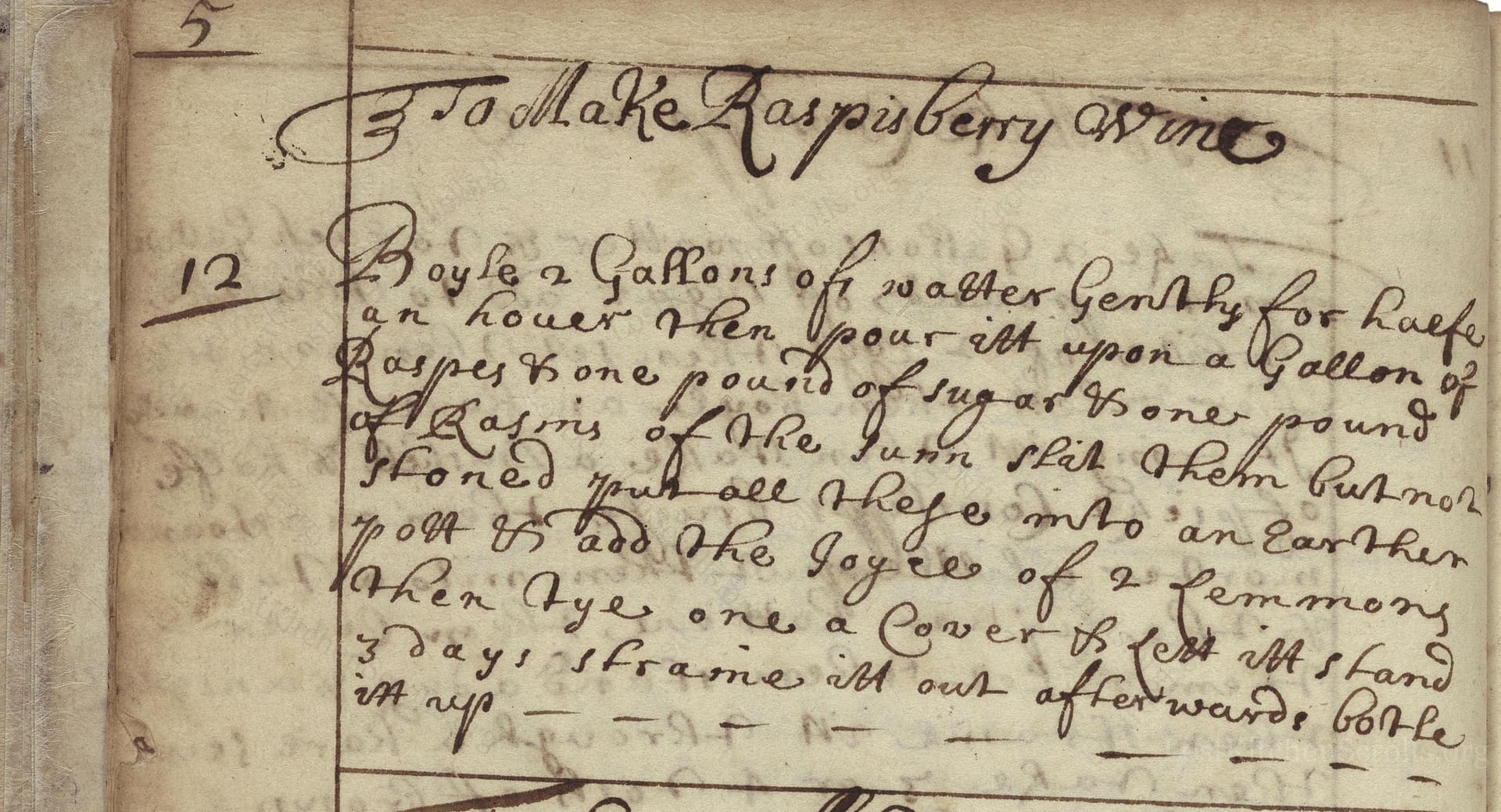To Make Raspbery Wine
From the treasured pages of Receipt book of Penelope Jephson
Written by Penelope Patrick

To Make Raspbery Wine
"Boyle 2 Gallons of watter Gently for halfe an houer Then pour itt upon a Gallon of Raspes bone pound of Sugar & one pound of Rasins of the Sunn slit Them But not washd putt all these into an Earthen pott & add The Joyce of 2 lemmons & when lyes one a Cover of lead itt stand 3 days & frame itt out afterwards Bottle itt up"
Note on the Original Text
Seventeenth-century English recipes are delightfully succinct, written in a practical, conversational tone but lacking in precise measurements or details by modern standards. Spelling was quite variable (e.g., 'watter' for 'water', 'Raspes' for 'raspberries', 'slit Them But not washd'), and quantities were often given by handful or 'pott' full. The instructions assume the cook's familiarity with preservation and fermentation techniques—in this case, the spontaneous fermentation from ambient yeasts on the fruit and raisins. The method reflects a time before refined measuring tools or scientific understanding of winemaking, relying instead on tradition and experience.

Title
Receipt book of Penelope Jephson (1673)
You can also click the book image above to peruse the original tome
Writer
Penelope Patrick
Era
1673
Publisher
Unknown
Background
Step back into the sumptuous kitchens of the late 17th century with Penelope Patrick’s culinary collection—a feast of historic recipes, secret tips, and the irresistible flavors of Restoration England all bound together in a handwritten treasure.
Kindly made available by
Folger Shakespeare Library
This recipe comes from the household manuscript of Penelope Patrick (1646-1725), dating from the early 1670s. In the 17th century, home winemaking was an important method for preserving the delicious fruits of the summer for year-round enjoyment, and fruit wines such as this raspberry wine would have been both a treat and a form of nutritional storage. Patrick, an Englishwoman in the Restoration era, likely recorded and adapted recipes circulating within her household and social networks. Fruit wines like this were a popular feature on genteel tables, evidencing both the resources and culinary ingenuity of historical homemakers.

Back in the 17th century, this raspberry wine would be made using basic kitchen implements. Water was boiled over an open hearth in a large cauldron or kettle. The fruit and sugar mixture was combined in an earthenware pot (sometimes referred to as a 'pott'), and the mixture was covered, commonly with a sheet of lead or a cloth. Straining would have been done with fine cloth or sieve, and the finished wine would be stored in glass bottles, often sealed with cork and wax. Today, you'd use a large stockpot, non-reactive fermentation vessel, measuring jugs, citrus juicer, fine mesh strainer or cheesecloth, and modern glass wine bottles with appropriate closures.
Prep Time
20 mins
Cook Time
30 mins
Servings
20
We've done our best to adapt this historical recipe for modern kitchens, but some details may still need refinement. We warmly welcome feedback from fellow cooks and culinary historians — your insights support the entire community!
Ingredients
- 2 gallons water
- 1 gallon fresh raspberries
- 1 pound granulated sugar
- 1 pound sun-dried raisins (unsulfured preferred), slit but not washed
- Juice of 2 lemons
Instructions
- Start by gently boiling 2 gallons of water for about 30 minutes to purify and concentrate it slightly.
- Pour the hot water over 1 gallon of fresh raspberries, 1 pound of granulated sugar, and 1 pound of 'raisins of the sun' (sun-dried raisins, preferably unsulfured) that have been slit but not washed, in a large non-reactive (ceramic or glass) vessel.
- Add the juice of 2 lemons.
- Cover loosely, ideally with a clean cloth or a modern food-safe lid that allows air movement, and let the mixture stand at room temperature for 3 days.
- After this period, strain out solids through a fine mesh or cheesecloth, bottle the liquid in sterilized bottles, and age as desired.
- Enjoy your raspberry wine once it has matured to your liking.
Estimated Calories
140 per serving
Cooking Estimates
It takes about 30 minutes to boil the water before pouring it over the fruit and sugar. Prep work like washing and juicing takes about 20 minutes. After mixing, the wine should stand for 3 days before straining and bottling. Each serving has about 140 calories. This recipe yields about 20 servings.
As noted above, we have made our best effort to translate and adapt this historical recipe for modern kitchens, taking into account ingredients nowadays, cooking techniques, measurements, and so on. However, historical recipes often contain assumptions that require interpretation.
We'd love for anyone to help improve these adaptations. Community contributions are highly welcome. If you have suggestions, corrections, or cooking tips based on your experience with this recipe, please share them below.
Join the Discussion
Rate This Recipe
Dietary Preference
Main Ingredients

Den Bockfisch In Einer Fleisch Suppen Zu Kochen
This recipe hails from a German manuscript cookbook compiled in 1696, a time whe...

Die Grieß Nudlen Zumachen
This recipe comes from a rather mysterious manuscript cookbook, penned anonymous...

Ein Boudain
This recipe comes from an anonymous German-language manuscript cookbook from 169...

Ein Gesaltzen Citroni
This recipe, dating from 1696, comes from an extensive anonymous German cookbook...
Browse our complete collection of time-honored recipes



